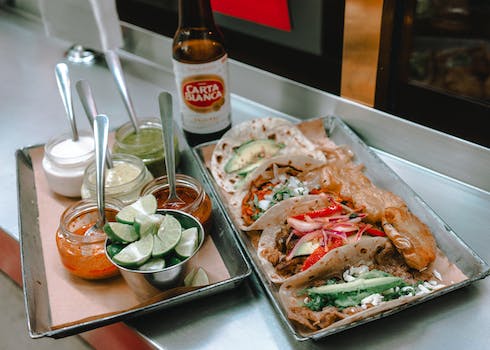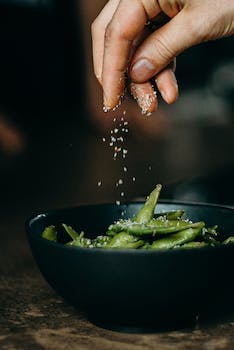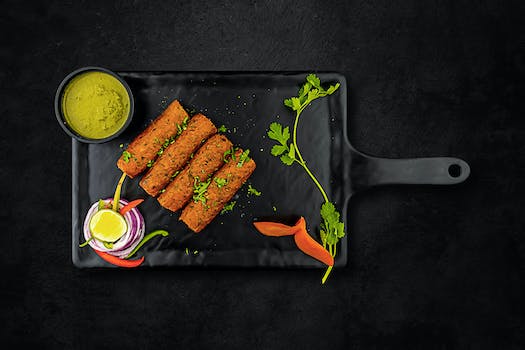

"St. Patrick's Day Feast: Savor the Tradition of Corned Beef and Cabbage"
Introduction
St. Patrick's Day, celebrated on March 17th, is a cultural and religious holiday commemorating the patron saint of Ireland, St. Patrick. One of the most iconic dishes associated with this festive occasion is corned beef and cabbage. This hearty meal has a rich history that dates back to the 17th century when the Irish began to salt-cure beef brisket as a means of preservation. The dish gained popularity among Irish-American immigrants in the 19th century, who found corned beef to be an affordable and flavorful alternative to their traditional Irish bacon. Today, corned beef and cabbage is a beloved staple of St. Patrick's Day feasts, symbolizing the blending of Irish heritage with American influences.
The Origins of Corned Beef and Cabbage on St. Patrick's Day
St. Patrick's Day is a time for celebration, and what better way to celebrate than with a traditional feast of corned beef and cabbage? This dish has become synonymous with the holiday, but its origins are not as Irish as one might think. In fact, the history of corned beef and cabbage is a rich tapestry that weaves together the culinary traditions of several cultures.
The story of corned beef and cabbage begins in Ireland, but not in the way you might expect. In Ireland, the traditional St. Patrick's Day meal was not corned beef and cabbage, but rather bacon and cabbage. Pork was the preferred meat in Ireland, and bacon was a staple of the Irish diet. However, when Irish immigrants came to America in the 19th century, they found that pork was much more expensive than beef. As a result, they turned to the cheaper alternative of corned beef.
The term "corned" beef comes from the large grains of salt, or "corns," that were used to cure the meat. This process of salting and curing the beef was a way to preserve it before the advent of refrigeration. The Irish immigrants learned this technique from their Jewish neighbors in New York City, who had been making corned beef for centuries. The Jewish butchers in the Lower East Side of Manhattan were known for their high-quality corned beef, and it quickly became a staple of the Irish-American diet.
As for the cabbage, it was a vegetable that was readily available and affordable for the Irish immigrants. It was also a familiar food, as cabbage had been a part of the Irish diet for centuries. When cooked together with the corned beef, the cabbage absorbed the flavors of the meat and the spices used in the curing process, creating a delicious and hearty meal.
Over time, corned beef and cabbage became associated with St. Patrick's Day, as it was a meal that could be easily prepared and shared with family and friends. It was also a way for Irish-Americans to celebrate their heritage and honor the patron saint of Ireland. Today, corned beef and cabbage is enjoyed by people of all backgrounds on St. Patrick's Day, and it has become a symbol of the holiday itself.
In addition to being a tasty dish, corned beef and cabbage is also a reminder of the immigrant experience in America. It is a testament to the resilience and adaptability of the Irish people, who were able to take the traditions of their homeland and blend them with the customs of their new country. It is a celebration of the melting pot that is America, where different cultures come together to create something new and wonderful.
So, as you sit down to enjoy your St. Patrick's Day feast of corned beef and cabbage, take a moment to reflect on the rich history of this dish. It is a story of immigration, adaptation, and the blending of cultures. It is a reminder that even in the face of adversity, people can come together to create something beautiful. And that is truly something to celebrate.
Traditional Irish Recipes for St. Patrick's Day Feast

St. Patrick's Day is a time for celebration, and what better way to honor the patron saint of Ireland than with a traditional feast? Corned beef and cabbage is a classic dish that has become synonymous with the holiday, but its history is as rich and complex as the flavors on the plate.
The origins of corned beef and cabbage can be traced back to the days when the Irish were a poor and oppressed people. Meat was a luxury that few could afford, and when they could, it was usually salted or "corned" to preserve it. Cabbage, on the other hand, was a staple in the Irish diet, as it was cheap, filling, and could be grown in abundance.
As the Irish began to immigrate to America in the 19th century, they brought their culinary traditions with them. However, they soon discovered that beef was much more affordable in their new home, and so they began to incorporate it into their meals. Corned beef and cabbage quickly became a popular dish among the Irish-American community, and it wasn't long before it was adopted as a symbol of St. Patrick's Day.
Today, corned beef and cabbage is enjoyed by people of all backgrounds, and it has become a beloved tradition for many families. The dish is typically made by slow-cooking corned beef in a flavorful broth with potatoes, carrots, and, of course, cabbage. The result is a hearty and satisfying meal that is perfect for a festive occasion.
But corned beef and cabbage is more than just a delicious dish; it is a reminder of the resilience and resourcefulness of the Irish people. It is a testament to their ability to adapt and thrive in the face of adversity, and it is a celebration of their rich cultural heritage.
As we gather around the table to enjoy our St. Patrick's Day feast, let us take a moment to reflect on the history behind the food we are eating. Let us remember the struggles and triumphs of the Irish people, and let us be inspired by their spirit of perseverance and determination.
So this St. Patrick's Day, let us raise a glass to the Emerald Isle and all that it represents. Let us savor the flavors of corned beef and cabbage, and let us give thanks for the traditions that have been passed down through the generations. And most importantly, let us come together in the spirit of friendship and community, for that is what this holiday is truly all about.
In conclusion, corned beef and cabbage is more than just a meal; it is a symbol of the enduring spirit of the Irish people. It is a reminder of the hardships they have overcome, and it is a celebration of their rich cultural heritage. So as we gather around the table this St. Patrick's Day, let us honor the past, savor the present, and look forward to the future with hope and optimism. Sláinte!
The Evolution of St. Patrick's Day Cuisine
St. Patrick's Day is a time for celebration, and what better way to celebrate than with a traditional feast of corned beef and cabbage? This iconic dish has become synonymous with the holiday, but its origins are not as Irish as one might think. In fact, the history of corned beef and cabbage is a rich tapestry that weaves together the culinary traditions of multiple cultures.
The story of corned beef and cabbage begins in Ireland, where beef was considered a luxury item reserved for the wealthy. The average Irish family would have eaten pork or bacon as their primary source of protein. However, when Irish immigrants arrived in America in the 19th century, they found that beef was much more affordable. They began to substitute beef for pork in their traditional dishes, and corned beef became a popular choice due to its long shelf life and low cost.
The term "corned" refers to the large grains of salt used to cure the beef, a process that dates back to ancient times. The salt was referred to as "corns" because of its size, and the beef was cured with it to preserve it for long periods. This method of preservation was essential for sailors and travelers who needed a reliable source of protein on their journeys.
Cabbage, on the other hand, has been a staple in the Irish diet for centuries. It was an inexpensive and hardy vegetable that could be grown in the harsh Irish climate. When combined with the salty, flavorful corned beef, it created a hearty and satisfying meal that was perfect for the cold, damp weather of Ireland.
As Irish immigrants settled in America, they brought their love of corned beef and cabbage with them. The dish became a popular menu item in Irish pubs and restaurants, and it wasn't long before it became associated with St. Patrick's Day. The holiday, which was originally a religious observance, had evolved into a celebration of Irish culture and heritage. And what better way to celebrate than with a traditional Irish meal?
Today, corned beef and cabbage is enjoyed by people of all backgrounds on St. Patrick's Day. It has become a symbol of the holiday, and a reminder of the rich history and cultural diversity that has shaped our modern world. The dish is a testament to the resilience and adaptability of the Irish people, who were able to take a humble cut of meat and turn it into a beloved culinary tradition.
As we gather around the table to enjoy our St. Patrick's Day feast, let us take a moment to reflect on the journey that brought corned beef and cabbage to our plates. It is a story of immigration, adaptation, and the blending of cultures. It is a reminder that food has the power to bring people together, to create new traditions, and to celebrate our shared history.
So this St. Patrick's Day, let us raise a glass to the rich history of corned beef and cabbage, and to the many hands that have prepared it over the years. May it continue to be a source of comfort, nourishment, and joy for generations to come. Sláinte!
Celebrating St. Patrick's Day: Corned Beef and Cabbage Pairings
St. Patrick's Day is a time for celebration, and what better way to honor the patron saint of Ireland than with a traditional feast of corned beef and cabbage? This classic dish has a rich history that dates back centuries, and it has become a staple of St. Patrick's Day celebrations around the world.
The origins of corned beef and cabbage can be traced back to the 17th century when the Irish began to salt and cure beef as a way to preserve it. The term "corned" comes from the large grains of salt, known as "corns," that were used in the curing process. This method of preservation was essential for the Irish, who relied on cured meats to sustain them through the long, harsh winters.
As the Irish began to emigrate to the United States in the 19th century, they brought their love of corned beef with them. However, they soon discovered that beef was much more expensive in America than it was back home. To save money, they turned to a cheaper cut of meat: brisket. This tough cut of beef required a long, slow cooking process to tenderize it, and the Irish found that boiling it with cabbage was the perfect way to do so.
Today, corned beef and cabbage is a beloved dish that is enjoyed by people of all backgrounds on St. Patrick's Day. The tender, flavorful beef pairs perfectly with the slightly sweet, slightly bitter taste of the cabbage, creating a hearty and satisfying meal that is perfect for a celebration.
But corned beef and cabbage is more than just a delicious dish; it is also a symbol of the Irish-American experience. It represents the struggles and triumphs of the Irish immigrants who came to America in search of a better life. It is a reminder of the hardships they faced, as well as the resilience and determination that allowed them to overcome those challenges.
As you sit down to enjoy your St. Patrick's Day feast of corned beef and cabbage, take a moment to reflect on the rich history of this dish. Think about the generations of Irish-Americans who have enjoyed it before you, and the ways in which it has become a part of the fabric of American culture.
And as you savor each bite, remember that corned beef and cabbage is more than just a meal; it is a celebration of the enduring spirit of the Irish people. It is a testament to their ability to adapt and thrive in a new land, and it is a reminder that even in the face of adversity, there is always a reason to celebrate.
So this St. Patrick's Day, raise a glass to the rich history of corned beef and cabbage, and to the Irish-Americans who have made it an integral part of our culinary heritage. Sláinte!
The Cultural Significance of Corned Beef and Cabbage on St. Patrick's Day
St. Patrick's Day is a time for celebration, and what better way to celebrate than with a traditional feast of corned beef and cabbage? This dish has become synonymous with the holiday, and for good reason. It is not only delicious but also steeped in rich history and cultural significance.
The tradition of eating corned beef and cabbage on St. Patrick's Day dates back to the early 20th century when Irish immigrants in America began to adopt the dish as their own. Corned beef was an affordable and readily available meat for the working-class Irish, and cabbage was a staple vegetable in their diet. The combination of the two became a symbol of their heritage and a way to celebrate their new lives in America.
But the history of corned beef and cabbage goes back even further. Corned beef, which is beef that has been cured in a salt brine, has been a popular dish in Ireland for centuries. It was originally made with salt pork, but as beef became more accessible, it became the meat of choice. Cabbage, on the other hand, has been a staple in Irish cuisine for thousands of years. It was a hardy vegetable that could be grown in the harsh Irish climate and was a reliable source of nutrition for the people.
The combination of corned beef and cabbage is not only a nod to the past but also a reflection of the Irish-American experience. It is a dish that has evolved over time, adapting to the changing tastes and circumstances of the people who make it. It is a dish that is both comforting and celebratory, a reminder of the struggles and triumphs of the Irish people.
On St. Patrick's Day, corned beef and cabbage is more than just a meal. It is a way to connect with one's heritage and to honor the memory of those who came before. It is a way to celebrate the resilience and strength of the Irish people, who have overcome adversity and made their mark on the world.
As we gather around the table to enjoy this traditional feast, we are reminded of the importance of family, community, and tradition. We are reminded of the power of food to bring people together and to create lasting memories. We are reminded of the rich history and cultural significance of corned beef and cabbage, and the role it plays in the celebration of St. Patrick's Day.
So, as we raise our glasses and toast to St. Patrick, let us also raise our forks and savor the flavors of this beloved dish. Let us take a moment to appreciate the journey it has taken to get to our plates, and the people who have made it possible. Let us celebrate the rich history and cultural significance of corned beef and cabbage, and the joy it brings to our St. Patrick's Day feast.
Q&A
1. Why is corned beef and cabbage associated with St. Patrick's Day?
Corned beef and cabbage became associated with St. Patrick's Day because Irish immigrants in America substituted corned beef for their traditional dish of bacon and cabbage, as it was more affordable.
2. What is the history behind corned beef?
Corned beef has its origins in Ireland, where it was a luxury item and often exported to other countries. It became popular in America among Irish immigrants in the 19th century.
3. How is corned beef traditionally prepared for St. Patrick's Day?
Corned beef is typically boiled with spices and served with cabbage and potatoes.
4. Is corned beef and cabbage a traditional Irish dish?
No, corned beef and cabbage is not a traditional Irish dish. It is an Irish-American adaptation.
5. What other foods are commonly served at a St. Patrick's Day feast?
Other common foods served at a St. Patrick's Day feast include Irish soda bread, shepherd's pie, and Irish stew.
Conclusion
In conclusion, St. Patrick's Day Feast, featuring corned beef and cabbage, has a rich history that dates back to the 17th century in Ireland. Originally a meal for the wealthy, it became a staple for Irish immigrants in America who used corned beef as a substitute for bacon. Today, it is a beloved tradition that celebrates Irish culture and heritage.












